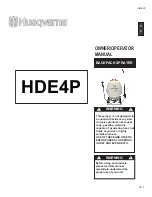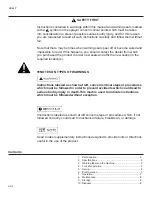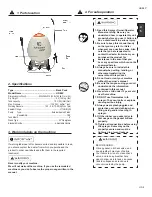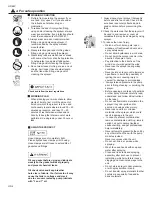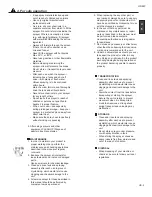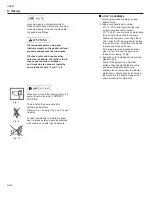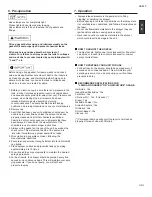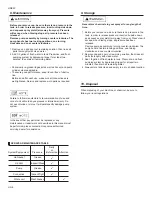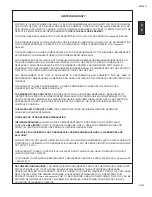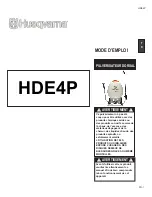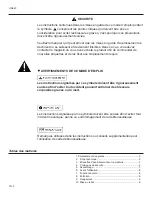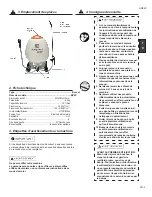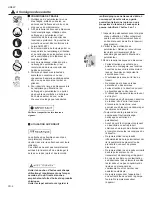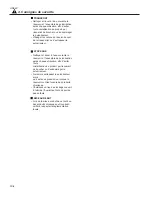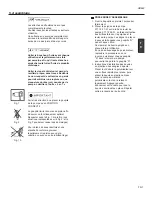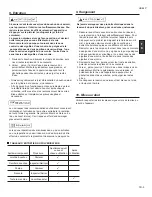
1. Refrain from operating the sprayer if you
are tired, ill, or upset, or if you are under
the influence of alcohol, drugs or
medication.
2. To reduce the risk of injury when filling,
using and/or cleaning the sprayer, always
wear eye protection. Eye protection should
meet the requirements of ANSI Z87.1.
3. Always wear a mask or respirator when
filling, using and cleaning sprayer, if
recommended by the spray material
manufacturer.
4. Wear protective gear and clothing when
filling, using and cleaning the sprayer.
5. Wear sturdy rubber-soled shoes or shoes
with some other form of anti-slip protection
to help protect you against falling when
filling, using and/or cleaning the sprayer.
6. Do not wear loose clothing, scarves, neck
chains, hair longer than shoulder length,
and the like when filling, using and/or
cleaning the sprayer.
• When planning your work schedule, allow
plenty of time to rest. Limit the amount of
time over which the product is to be used
continuously to somewhere around 30 ~ 40
minutes per session, and take 10 ~ 20
minutes of rest between work sessions.
Also try to keep the total amount of work
performed in a single day under 2 hours or
less.
Hose clamps are not completely tight.
Please tighten hose clamps prior to using.
Hose clamps are left loose to extend life of
gaskets and fittings.
Oil cap gasket before using and lubricate
weekly so the gasket will seal properly
and prevent chemical leaks.
Oil check valve and keep breather
hole clear of debris. Your failure to oil may
cause the tank to collapse and crack
due to vacuum created by pump lubricate
with “3 and 1” oil.
1. Always inspect your sprayer thoroughly
before and after each use. Check to be
sure hose is securely attached and in
good condition before pressurizing the
tank.
2. Check the work area that the sprayer will
be used in and remove or cover all
valuables that may be damaged by using
sprayer.
3. To reduce the risk of injury,
• Watch out for children, pets, open
windows or freshly washed cars, and
spray safely away.
• Do not allow bystanders in work area.
• Do not point the sprayer nozzle in the
direction of people or pets.
• Pay attention to the direction of the
wind, do not work against the wind.
• Never use the sprayer during windy
conditions.
• Never point a sprayer nozzle toward an
open flame to avoid the possibility of
igniting the unit, causing injury to
yourself or damage to surroundings.
• Always release pressure in the pump
prior to filling, cleaning, or servicing the
sprayer.
• Before opening a container of pesticide
or other spray material, carefully read,
understand, and follow all instructions
on the label.
• Do not use flammable materials in the
sprayer: they can ignite and/or
explo de, causing serious injury.
• Never use caustic or corrosive
materials in the sprayer, which could
result in damage to the unit.
• In case of personal contamination:
remove contaminated clothing, remain
upright, do not consume liquids or
cause vomiting, and get professional
help immediately.
• Never attempt to pressurize the unit by
any other method than with the pump
module provided.
Never over-pressurize the unit.
• Do not eat, drink, or smoke while
spraying.
• Wash face and hands with soap and
water after spraying.
• Clean and rinse tank and spraying
assembly after each use to prevent
rystallizing, which would later cause
clogging and chemical damage to the
unit.
• Do not store sprayer under pressure,
or with spray solution in tank.
• Do not transfer spray materials to other
containers, especially, food and/or
drink containers.
4. For safe operation
WORKING CONDITION
WORKING PLAN
USING THE PRODUCT
Check and follow the local regulations.
HDE
4P
US-4



